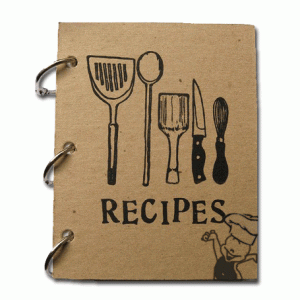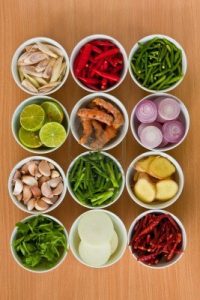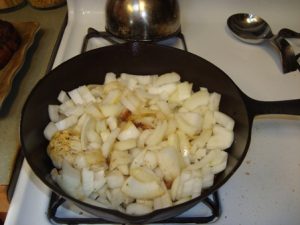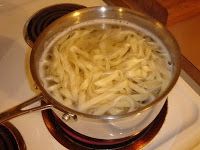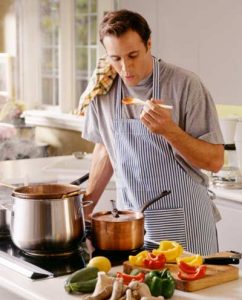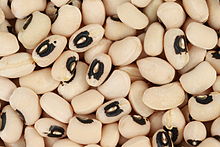Even experienced cooks make mistakes. But novice cooks often get too wrapped up in recipes and not enough attention on technique. Proper technique can make a huge difference in the quality of your meal.
It’s important enough that The Bachelor’s Kitchen continues taking a look at the most common mistakes and how to avoid them.
First, You Read
Believe it or not, it all starts before you cook a single thing. Make sure you read through the recipe before you do anything! Not only do you want to check if you have all the ingredients, but you want to be sure you have the proper equipment. Many times you can make do with what you have. But just as often, not having the tools or pans you need can stop your preparations in their tracks. We’ve often wanted to make a particular dish only to discover we don’t have everything we need. Sometimes a quick trip to the store can solve that. But you don’t want to do that after the food gets on the stove or in the oven. That leads to a disaster.
Mis En Place Not Somewhere In France
As a part of your preparations, get all your ingredients together. Pay attention to whether vegetables need chopping, meat needs cutting into pieces or spices need to be mixed together. Also, you can eliminate the number of small bowls of ingredients by knowing which ones will be added to the pot together. Sometimes there is time between steps to pull other ingredients together, but usually there isn’t. Getting them all ready before you begin cooking saves a lot of worry and stress in cooking. Also, you are less likely to leave something out. We’ve done that many times in The Bachelor’s Kitchen, with terrible or bland results.
Knowing When Things Should Be Hot
Heat pans before adding anything. The only exception to this rule is if you are cooking with water. In that case, add the water or broth before putting the pot on the heat. But in general, it’s better to heat the pan first. We usually put the pans on the stove as we are pulling together our ingredients together. Then we turn the heat on low to let them warm up as we prepare the things going into the pans. When we’re ready, we turn the heat up, wait a minute or two, then start cooking. Don’t add oil or cooking fat into the pan while it’s heating up. If the oil gets too hot it will burn. Adding the fat just before you start cooking will be fine because it will heat up quickly in the hot pan.
Temperature is important in cooking. Not only should the pan be at the right temperature, but so should your ingredients. This is especially true in baking. Water to activate yeast needs to be 110ºF. Butter, milk, cream and eggs all should be at room temperature. In fact, most cooking should use ingredients at room temperature unless otherwise noted in the recipe. If you forget to get your ingredients out of the refrigerator ahead of time, there are ways to speed up the process. Butter cut into small pieces and eggs soaking in warm water will lessen the time needed to bring them up to the right temperature.
Back Off! I’m Cookin’ Here!
Another common mistake is to overcrowd the food in your pans. If you are browning something, not leaving a little room between the pieces of food traps the moisture being drawn out of the food. That means you food is actually steaming rather than browning. Yes, the food will eventually get brown, but you will overcook the food and it will take much longer than it should. If you have more ingredients than will fit in you pan, cook them in batches.
Some people think you just need enough water to cover pasta in order to cook it. Wrong! You need a lot more or you get a clump of pasta sticking together in a big mess. You also need a pot large enough to give the pasta plenty of room to cook and expand. Experts recommend at least 4 cups of water for every half pound of pasta. And remember to salt the water well, until it tastes like sea water. This is your only chance to season the pasta.
Food Relaxation
Almost all hot foods benefit from a little rest after cooking. This is especially true of meat. Always allow meat and other cooked foods a few minutes rest before cutting or serving. Why? Well, it’s simple physics. Heat causes the molecules in the food to move—fast. And those little bits of matter, whether solid or liquid, are looking for some place to go. When you cut into meat just out of the oven, the most fluid molecules, the liquid, will run out all over the cutting board. That leaves the meat dry and tough. Give those tiny molecules a chance to cool down, slow down, and settle in to their final positions. It will give you better tasting food.
You Are Your Best Guide
Speaking of taste, one of the cardinal rules of cooking is to taste, taste, taste. Most of the time, seasonings, especially salt, should be used right from the beginning of cooking. But use a light touch, because in most cases you can add more salt later on if needed. Salt thoroughly but not heavily as you introduce your ingredients to the pan. The salt will bring out flavors you cannot obtain if you wait until the end. Just don’t overdo it. You can always add more, but once added you can’t take it out again.
Use The Right Tools
Americans love their labor-saving devices. One of the most treasured in the kitchen is the dishwasher. But not everything can go into the dishwasher, like light-weight plastic and anything with wood or bamboo. You should have a good set of knives in your kitchen. And if you do, do NOT put them in the dishwasher. Same applies to your good cooking pans, especially our favorite, the cast iron skillet. Let the dishwasher handle the plates, glasses and cups, while you wash the small number of knives, utensils and cooking pans. How does that affect the quality of your food? No one like the cook’s blood in their dish. A dull knife is more likely to cut you than a sharp one.
Use the right measuring tools, especially when baking. It’s not rocket science. Use dry measuring cups and spoons for dry ingredients and liquid measuring cups for wet ingredients. The simple fact is the two are not interchangeable.
A little common sense, and you can avoid lots of kitchen disasters.
